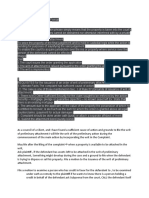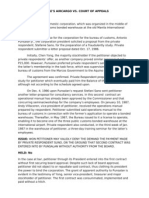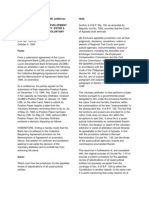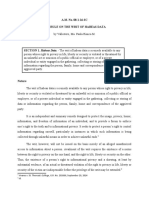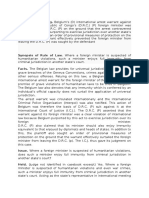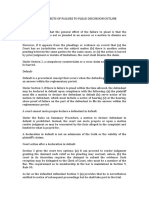Writ of Amparo
Writ of Amparo
Uploaded by
claudette2014Copyright:
Available Formats
Writ of Amparo
Writ of Amparo
Uploaded by
claudette2014Original Description:
Copyright
Available Formats
Share this document
Did you find this document useful?
Is this content inappropriate?
Copyright:
Available Formats
Writ of Amparo
Writ of Amparo
Uploaded by
claudette2014Copyright:
Available Formats
Today is Tuesday, December 31, 2013
Republic of the Philippines SUPREME COURT Manila A.M. No. 07-9-12-SC (25 September 2007) THE RULE ON THE R!T O" AMPARO
SECT!ON 1. Petition. The petition for a writ of amparo is a remedy available to any person whose right to life, liberty and security is violated or threatened with violation by an unlawful act or omission of a public official or employee, or of a private individual or entity. The writ shall cover extralegal killings and enforced disappearances or threats thereof. SEC. 2. Who May File. The petition may be filed by the aggrieved party or by any ualified person or entity in the following order! a. "ny member of the immediate family, namely! the spouse, children and parents of the aggrieved party# b. "ny ascendant, descendant or collateral relative of the aggrieved party within the fourth civil degree of consanguinity or affinity, in default of those mentioned in the preceding paragraph# or c. "ny concerned citi$en, organi$ation, association or institution, if there is no known member of the immediate family or relative of the aggrieved party. The filing of a petition by the aggrieved party suspends the right of all other authori$ed parties to file similar petitions. %ikewise, the filing of the petition by an authori$ed party on behalf of the aggrieved party suspends the right of all others, observing the order established herein. SEC. #. Where to File. The petition may be filed on any day and at any time with the Regional Trial &ourt of the place where the threat, act or omission was committed or any of its elements occurred, or with the 'andiganbayan, the &ourt of "ppeals, the 'upreme &ourt, or any (ustice of such courts. The writ shall be enforceable anywhere in the Philippines. )hen issued by a Regional Trial &ourt or any (udge thereof, the writ shall be returnable before such court or (udge. )hen issued by the 'andiganbayan or the &ourt of "ppeals or any of their (ustices, it may be returnable before such court or any (ustice thereof, or to any Regional Trial &ourt of the place where the threat, act or omission was committed or any of its
elements occurred. )hen issued by the 'upreme &ourt or any of its (ustices, it may be returnable before such &ourt or any (ustice thereof, or before the 'andiganbayan or the &ourt of "ppeals or any of their (ustices, or to any Regional Trial &ourt of the place where the threat, act or omission was committed or any of its elements occurred. SEC. $. No Docket Fees. The petitioner shall be exempted from the payment of the docket and other lawful fees when filing the petition. The court, (ustice or (udge shall docket the petition and act upon it immediately. SEC. 5. Contents of Petition. The petition shall be signed and verified and shall allege the following! a. The personal circumstances of the petitioner# b. The name and personal circumstances of the respondent responsible for the threat, act or omission, or, if the name is unknown or uncertain, the respondent may be described by an assumed appellation# c. The right to life, liberty and security of the aggrieved party violated or threatened with violation by an unlawful act or omission of the respondent, and how such threat or violation is committed with the attendant circumstances detailed in supporting affidavits# d. The investigation conducted, if any, specifying the names, personal circumstances, and addresses of the investigating authority or individuals, as well as the manner and conduct of the investigation, together with any report# e. The actions and recourses taken by the petitioner to determine the fate or whereabouts of the aggrieved party and the identity of the person responsible for the threat, act or omission# and f. The relief prayed for. The petition may include a general prayer for other (ust and e uitable reliefs. SEC. %. Issuance of the Writ. *pon the filing of the petition, the court, (ustice or (udge shall immediately order the issuance of the writ if on its face it ought to issue. The clerk of court shall issue the writ under the seal of the court# or in case of urgent necessity, the (ustice or the (udge may issue the writ under his or her own hand, and may deputi$e any officer or person to serve it. The writ shall also set the date and time for summary hearing of the petition which shall not be later than seven +,- days from the date of its issuance. SEC. 7. Penalty for Refusing to Issue or Serve the Writ. " clerk of court who refuses to issue the writ after its allowance, or a deputi$ed person who refuses to serve the same, shall be punished by the court, (ustice or (udge for contempt without pre(udice to other disciplinary actions. SEC. &. How the Writ is Serve . The writ shall be served upon the respondent by a (udicial officer or by a person deputi$ed by the court, (ustice or (udge who shall retain a copy on which to make a return of service. .n case the writ cannot be served personally on the respondent, the rules on substituted service shall apply. SEC. 9. Return! Contents. )ithin seventy/two +,0- hours after service of the writ, the respondent shall file a verified
written return together with supporting affidavits which shall, among other things, contain the following! a. The lawful defenses to show that the respondent did not violate or threaten with violation the right to life, liberty and security of the aggrieved party, through any act or omission# b. The steps or actions taken by the respondent to determine the fate or whereabouts of the aggrieved party and the person or persons responsible for the threat, act or omission# c. "ll relevant information in the possession of the respondent pertaining to the threat, act or omission against the aggrieved party# and d. .f the respondent is a public official or employee, the return shall further state the actions that have been or will still be taken! i. ii. iii. iv. v. vi. to verify the identity of the aggrieved party# to recover and preserve evidence related to the death or disappearance of the person identified in the petition which may aid in the prosecution of the person or persons responsible# to identify witnesses and obtain statements from them concerning the death or disappearance# to determine the cause, manner, location and time of death or disappearance as well as any pattern or practice that may have brought about the death or disappearance# to identify and apprehend the person or persons involved in the death or disappearance# and to bring the suspected offenders before a competent court.
The return shall also state other matters relevant to the investigation, its resolution and the prosecution of the case. " general denial of the allegations in the petition shall not be allowed. SEC. 10. Defenses not Plea e Dee"e Waive . 1 "ll defenses shall be raised in the return, otherwise, they shall be deemed waived. SEC. 11. Prohi#ite Plea ings an Motions. The following pleadings and motions are prohibited! a. Motion to dismiss# b. Motion for extension of time to file return, opposition, affidavit, position paper and other pleadings# c. 2ilatory motion for postponement# d. Motion for a bill of particulars# e. &ounterclaim or cross/claim# f. Third/party complaint# g. Reply# h. Motion to declare respondent in default#
i. .ntervention# (. Memorandum# k. Motion for reconsideration of interlocutory orders or interim relief orders# and l. Petition for certiorari, mandamus or prohibition against any interlocutory order. SEC. 12. $ffect of Failure to File Return. 1 .n case the respondent fails to file a return, the court, (ustice or (udge shall proceed to hear the petition ex parte. SEC. 1#. Su""ary Hearing. 1 The hearing on the petition shall be summary. 3owever, the court, (ustice or (udge may call for a preliminary conference to simplify the issues and determine the possibility of obtaining stipulations and admissions from the parties. The hearing shall be from day to day until completed and given the same priority as petitions for habeas corpus. SEC. 1$. Interi" Reliefs. 1 *pon filing of the petition or at anytime before final (udgment, the court, (ustice or (udge may grant any of the following reliefs! +a- Temporary Protection 4rder. The court, (ustice or (udge, upon motion or motu proprio, may order that the petitioner or the aggrieved party and any member of the immediate family be protected in a government agency or by an accredited person or private institution capable of keeping and securing their safety. .f the petitioner is an organi$ation, association or institution referred to in 'ection 5+c- of this Rule, the protection may be extended to the officers involved. The 'upreme &ourt shall accredit the persons and private institutions that shall extend temporary protection to the petitioner or the aggrieved party and any member of the immediate family, in accordance with guidelines which it shall issue. The accredited persons and private institutions shall comply with the rules and conditions that may be imposed by the court, (ustice or (udge. +b- .nspection 4rder. 1 The court, (ustice or (udge, upon verified motion and after due hearing, may order any person in possession or control of a designated land or other property, to permit entry for the purpose of inspecting, measuring, surveying, or photographing the property or any relevant ob(ect or operation thereon. The motion shall state in detail the place or places to be inspected. .t shall be supported by affidavits or testimonies of witnesses having personal knowledge of the enforced disappearance or whereabouts of the aggrieved party. .f the motion is opposed on the ground of national security or of the privileged nature of the information, the court, (ustice or (udge may conduct a hearing in chambers to determine the merit of the opposition. The movant must show that the inspection order is necessary to establish the right of the aggrieved party alleged to be threatened or violated. The inspection order shall specify the person or persons authori$ed to make the inspection and the date, time,
place and manner of making the inspection and may prescribe other conditions to protect the constitutional rights of all parties. The order shall expire five +6- days after the date of its issuance, unless extended for (ustifiable reasons. +c- Production 4rder. The court, (ustice or (udge, upon verified motion and after due hearing, may order any person in possession, custody or control of any designated documents, papers, books, accounts, letters, photographs, ob(ects or tangible things, or ob(ects in digiti$ed or electronic form, which constitute or contain evidence relevant to the petition or the return, to produce and permit their inspection, copying or photographing by or on behalf of the movant. The motion may be opposed on the ground of national security or of the privileged nature of the information, in which case the court, (ustice or (udge may conduct a hearing in chambers to determine the merit of the opposition. The court, (ustice or (udge shall prescribe other conditions to protect the constitutional rights of all the parties. +d- )itness Protection 4rder. The court, (ustice or (udge, upon motion or motu proprio, may refer the witnesses to the 2epartment of 7ustice for admission to the )itness Protection, 'ecurity and 8enefit Program, pursuant to Republic "ct 9o. :;<=. The court, (ustice or (udge may also refer the witnesses to other government agencies, or to accredited persons or private institutions capable of keeping and securing their safety. SEC. 15. %vaila#ility of Interi" Reliefs to Res&on ent. *pon verified motion of the respondent and after due hearing, the court, (ustice or (udge may issue an inspection order or production order under paragraphs +b- and +c- of the preceding section. " motion for inspection order under this section shall be supported by affidavits or testimonies of witnesses having personal knowledge of the defenses of the respondent. SEC. 1%. Conte"&t. The court, (ustice or (udge may order the respondent who refuses to make a return, or who makes a false return, or any person who otherwise disobeys or resists a lawful process or order of the court to be punished for contempt. The contemnor may be imprisoned or imposed a fine. SEC. 17. 'ur en of Proof an Stan ar of Diligence Re(uire . The parties shall establish their claims by substantial evidence. The respondent who is a private individual or entity must prove that ordinary diligence as re uired by applicable laws, rules and regulations was observed in the performance of duty. The respondent who is a public official or employee must prove that extraordinary diligence as re uired by applicable laws, rules and regulations was observed in the performance of duty. The respondent public official or employee cannot invoke the presumption that official duty has been regularly performed to
evade responsibility or liability. SEC. 1&. )u g"ent. 1 The court shall render (udgment within ten +=>- days from the time the petition is submitted for decision. .f the allegations in the petition are proven by substantial evidence, the court shall grant the privilege of the writ and such reliefs as may be proper and appropriate# otherwise, the privilege shall be denied. SEC. 19. %&&eal. "ny party may appeal from the final (udgment or order to the 'upreme &ourt under Rule ?6. The appeal may raise uestions of fact or law or both. The period of appeal shall be five +6- working days from the date of notice of the adverse (udgment. The appeal shall be given the same priority as in habeas corpus cases. SEC. 20. %rchiving an Revival of Cases. The court shall not dismiss the petition, but shall archive it, if upon its determination it cannot proceed for a valid cause such as the failure of petitioner or witnesses to appear due to threats on their lives. " periodic review of the archived cases shall be made by the amparo court that shall, motu proprio or upon motion by any party, order their revival when ready for further proceedings. The petition shall be dismissed with pre(udice upon failure to prosecute the case after the lapse of two +0- years from notice to the petitioner of the order archiving the case. The clerks of court shall submit to the 4ffice of the &ourt "dministrator a consolidated list of archived cases under this Rule not later than the first week of 7anuary of every year. SEC. 21. Institution of Se&arate %ctions. 1 This Rule shall not preclude the filing of separate criminal, civil or administrative actions. SEC. 22. $ffect of Filing of a Cri"inal %ction. )hen a criminal action has been commenced, no separate petition for the writ shall be filed. The reliefs under the writ shall be available by motion in the criminal case. The procedure under this Rule shall govern the disposition of the reliefs available under the writ of amparo. SEC. 2#. Consoli ation. )hen a criminal action is filed subse uent to the filing of a petition for the writ, the latter shall be consolidated with the criminal action. )hen a criminal action and a separate civil action are filed subse uent to a petition for a writ of amparo, the latter shall be consolidated with the criminal action. "fter consolidation, the procedure under this Rule shall continue to apply to the disposition of the reliefs in the petition. SEC. 2$. Su#stantive Rights. 1 This Rule shall not diminish, increase or modify substantive rights recogni$ed and protected by the &onstitution. SEC. 25. Su&&letory %&&lication of the Rules of Court. The Rules of &ourt shall apply suppletorily insofar as it is not
inconsistent with this Rule. SEC. 2%. %&&lica#ility to Pen ing Cases. This Rule shall govern cases involving extralegal killings and enforced disappearances or threats thereof pending in the trial and appellate courts. SEC. 27. $ffectivity. This Rule shall take effect on 4ctober 0?, 0>>,, following its publication in three +5- newspapers of general circulation. The %awphil Pro(ect / "rellano %aw @oundation
You might also like
- Revised Penal Code Part 2 (Reyes) (2021)Document198 pagesRevised Penal Code Part 2 (Reyes) (2021)Aimee Venteroso94% (18)
- PEOPLE V MICHAEL JACKSON - Court Transcript 5-12-2005.Document385 pagesPEOPLE V MICHAEL JACKSON - Court Transcript 5-12-2005.TeamMichael100% (1)
- Prerogative WritsDocument15 pagesPrerogative WritsAling KinaiNo ratings yet
- RULE 103 Rules of CourtDocument2 pagesRULE 103 Rules of Courtwinter_equinox4No ratings yet
- Writ of Habeas Data CasesDocument10 pagesWrit of Habeas Data CasesChristine ErnoNo ratings yet
- Torts (Scope of Quasi Delict)Document7 pagesTorts (Scope of Quasi Delict)JunRobotboiNo ratings yet
- Bayan (Bagong Alyansang Makabayan) vs. Zamora, 342 SCRA 449 (2000Document62 pagesBayan (Bagong Alyansang Makabayan) vs. Zamora, 342 SCRA 449 (2000Betson CajayonNo ratings yet
- G.R. No. 105141 August 31, 1993 SIGNETICS CORPORATION, Petitioner, Court of Appeals and Fruehauf Electronics Phils. Inc., RespondentsDocument8 pagesG.R. No. 105141 August 31, 1993 SIGNETICS CORPORATION, Petitioner, Court of Appeals and Fruehauf Electronics Phils. Inc., RespondentsJames WilliamNo ratings yet
- National Sugar V CADocument4 pagesNational Sugar V CAMichael MatnaoNo ratings yet
- 03 People v. Aquino GR 128887 20jan2000Document12 pages03 People v. Aquino GR 128887 20jan2000Jm CruzNo ratings yet
- Provrem - Olsen VS OlsenDocument2 pagesProvrem - Olsen VS OlsenJulioNo ratings yet
- Torts and Damages: San Beda College of LawDocument43 pagesTorts and Damages: San Beda College of LawVincent De VeraNo ratings yet
- 10-G.R No. 148597Document4 pages10-G.R No. 148597Sugar ReeNo ratings yet
- Comparison of 1997 CivPro Rules Submitted To The Banc Jan. 10 2020 With AnnotationDocument99 pagesComparison of 1997 CivPro Rules Submitted To The Banc Jan. 10 2020 With AnnotationachiNo ratings yet
- Priscilla MijaresDocument2 pagesPriscilla MijaresbingNo ratings yet
- Lesson 3. Specialized Crime InvestigationDocument14 pagesLesson 3. Specialized Crime InvestigationSilver LisingNo ratings yet
- Requirement For Provisional RemedyDocument5 pagesRequirement For Provisional RemedyEdsel Ian S. FuentesNo ratings yet
- Right To InspectDocument6 pagesRight To InspectOlan Dave LachicaNo ratings yet
- Campos Vs OrtegaDocument4 pagesCampos Vs OrtegaKC BarrasNo ratings yet
- Judicial Affidavit RuleDocument32 pagesJudicial Affidavit RuleedcaratsNo ratings yet
- Provisional Remedies TableDocument6 pagesProvisional Remedies TableJovie Hernandez-MiraplesNo ratings yet
- 434 Supreme Court Reports Annotated: Nario vs. Philippine American Life Ins. CoDocument8 pages434 Supreme Court Reports Annotated: Nario vs. Philippine American Life Ins. CoAmer Lucman IIINo ratings yet
- Canon 18 CasesDocument15 pagesCanon 18 CasesMargarette Pinkihan SarmientoNo ratings yet
- People Aircago Vs CADocument2 pagesPeople Aircago Vs CACarol DonsolNo ratings yet
- Secretary, Treasurer, or In-House Counsel. Rebollido Vs Ca (Pepsico)Document24 pagesSecretary, Treasurer, or In-House Counsel. Rebollido Vs Ca (Pepsico)cmv mendozaNo ratings yet
- Labor Relation Case DigestDocument3 pagesLabor Relation Case Digestunosais50% (2)
- Baluyut v. PanoDocument1 pageBaluyut v. PanoCarlo MarcaidaNo ratings yet
- Rule 57-58 MinidigestsDocument4 pagesRule 57-58 MinidigestsGem LiNo ratings yet
- Report1 (Feb. 9)Document13 pagesReport1 (Feb. 9)Mary LouiseNo ratings yet
- Case Digest - Articles 220-221, FAMILY CODE - Tamargo V CaDocument4 pagesCase Digest - Articles 220-221, FAMILY CODE - Tamargo V CaZhadlerNo ratings yet
- Cecilio V. Suarez, Jr. For Spouses Fontanilla. Felicisimo C. Villaflor For NIADocument7 pagesCecilio V. Suarez, Jr. For Spouses Fontanilla. Felicisimo C. Villaflor For NIAMarie CecileNo ratings yet
- Gonzalez v. Ordonez BenitezDocument2 pagesGonzalez v. Ordonez BenitezGladys Bustria OrlinoNo ratings yet
- Real, Because Most of The Time The Children Will Not Be Granted Sa FathersDocument4 pagesReal, Because Most of The Time The Children Will Not Be Granted Sa FathersJay MarieNo ratings yet
- Notes On Special Civil Actions: Definition/Concept of SCADocument22 pagesNotes On Special Civil Actions: Definition/Concept of SCAMichelle Kristine AnteNo ratings yet
- Presumptive Legitimes of Children in Annulled Marriages ArticleConvert - Feb.2.2004Document1 pagePresumptive Legitimes of Children in Annulled Marriages ArticleConvert - Feb.2.2004Husayn TamanoNo ratings yet
- De La Salle Vs de La SalleDocument7 pagesDe La Salle Vs de La SallePhrexilyn PajarilloNo ratings yet
- Laws On Divorce: A Comparative Research Between Philippine, International, and Religious ConceptsDocument16 pagesLaws On Divorce: A Comparative Research Between Philippine, International, and Religious ConceptsJheanne Francheska AguilarNo ratings yet
- Government of The Philippine Islands V MartinezDocument3 pagesGovernment of The Philippine Islands V MartinezejarcegaNo ratings yet
- 0130 G.R. No. 150197 July 28, 2005 Prudential Bank Vs Don A. AlviarDocument5 pages0130 G.R. No. 150197 July 28, 2005 Prudential Bank Vs Don A. AlviarrodolfoverdidajrNo ratings yet
- Answer To Complaint IPRA DraftDocument2 pagesAnswer To Complaint IPRA DraftApple Buhion Ke-eNo ratings yet
- New Civil ProcDocument199 pagesNew Civil ProcKen DG CNo ratings yet
- SucDocument2 pagesSucAlthea EstrellaNo ratings yet
- Minucher V CADocument2 pagesMinucher V CAHenry G Funda IINo ratings yet
- 80 SSS V COADocument15 pages80 SSS V COAKirsten Denise B. Habawel-VegaNo ratings yet
- Calderon vs. Roxas - Provisional RemediesDocument7 pagesCalderon vs. Roxas - Provisional RemediesVloudy Mia Serrano PangilinanNo ratings yet
- 2 Provrem Central Sawmill Vs Alto SuretyDocument10 pages2 Provrem Central Sawmill Vs Alto SuretyNicholas FoxNo ratings yet
- A.M. No. 08-1-16-SC The Rule On The Writ of Habeas DataDocument8 pagesA.M. No. 08-1-16-SC The Rule On The Writ of Habeas DataPaula VallesteroNo ratings yet
- Rule 18 Pre-Trial: Midterms - Judge DocenaDocument5 pagesRule 18 Pre-Trial: Midterms - Judge DocenaShaiNo ratings yet
- Grandfather Rule - Illustration Using PaltingDocument4 pagesGrandfather Rule - Illustration Using PaltingJune RudiniNo ratings yet
- Writ of KalikasanDocument11 pagesWrit of KalikasanMichelle Dulce Mariano CandelariaNo ratings yet
- Preliminary Attachment: RD RDDocument3 pagesPreliminary Attachment: RD RDcarinokatrina100% (1)
- Arrest Warrant CaseDocument3 pagesArrest Warrant CaseArpitDwivediNo ratings yet
- 5-UST V SurlaDocument7 pages5-UST V SurlaChoi ChoiNo ratings yet
- Rule 9 - Effects of Failure To Plead Discussion OutlineDocument3 pagesRule 9 - Effects of Failure To Plead Discussion OutlineKodeconNo ratings yet
- Nachura JurisprudenceDocument198 pagesNachura JurisprudenceVanessa Baltao100% (1)
- Reserva Troncal NotesDocument2 pagesReserva Troncal NotesMela SuarezNo ratings yet
- Vs. ROSALINA C. BIASCAN, Respondent.: G.R. No. 138731. December 11, 2000Document5 pagesVs. ROSALINA C. BIASCAN, Respondent.: G.R. No. 138731. December 11, 2000RPCO 4B PRDP IREAPNo ratings yet
- Kenneth ManuelDocument4 pagesKenneth ManuelAmalia AlelojoNo ratings yet
- 4 Remedial LawDocument6 pages4 Remedial LawJG UdNo ratings yet
- Effect of Failure To Plead 9Document1 pageEffect of Failure To Plead 9arloNo ratings yet
- rULE ON wRIT OF aMPARODocument7 pagesrULE ON wRIT OF aMPAROjafernandNo ratings yet
- The Rule On The Writ of AmparoDocument7 pagesThe Rule On The Writ of AmparoT Cel MrmgNo ratings yet
- Microsoft Corporation v. Corel - Corel's Motion For Leave To AmendDocument81 pagesMicrosoft Corporation v. Corel - Corel's Motion For Leave To AmendSarah BursteinNo ratings yet
- UnpublishedDocument13 pagesUnpublishedScribd Government DocsNo ratings yet
- CP Netherlands ENGDocument8 pagesCP Netherlands ENGFlower PowerNo ratings yet
- BN Legal SystemService Previlige 1Document18 pagesBN Legal SystemService Previlige 1M HASIN ISHMAM JEETNo ratings yet
- Miguel V MontanezDocument2 pagesMiguel V MontanezDana Denisse RicaplazaNo ratings yet
- "Nemo Moriturus Praesumitur Mentire: Indian Evidence ActDocument14 pages"Nemo Moriturus Praesumitur Mentire: Indian Evidence Actshivam mishraNo ratings yet
- Darrell Gene Devier, Sr. v. Walter Zant, Warden, Georgia Diagnostic and Classification Center, Cross-Appellee. Darrell Gene Devier, Sr. v. Walter Zant, Warden, Georgia Diagnostic and Classification Center, 3 F.3d 1445, 11th Cir. (1993)Document33 pagesDarrell Gene Devier, Sr. v. Walter Zant, Warden, Georgia Diagnostic and Classification Center, Cross-Appellee. Darrell Gene Devier, Sr. v. Walter Zant, Warden, Georgia Diagnostic and Classification Center, 3 F.3d 1445, 11th Cir. (1993)Scribd Government DocsNo ratings yet
- Lim Teck Kong V DR Abdul Hamid Abdul Rashid & AnorDocument22 pagesLim Teck Kong V DR Abdul Hamid Abdul Rashid & Anorengyi96No ratings yet
- Final ExamDocument2 pagesFinal ExamGloria TrầnNo ratings yet
- GOP State AGs LawsuitDocument33 pagesGOP State AGs LawsuitLaw&CrimeNo ratings yet
- Glencore, Ltd. v. Schnitzer Steel Products Co., Halla Merchant Marine Co., LTD., As Disponent Owner of The M/V Caravos Explorer, 189 F.3d 264, 2d Cir. (1999)Document6 pagesGlencore, Ltd. v. Schnitzer Steel Products Co., Halla Merchant Marine Co., LTD., As Disponent Owner of The M/V Caravos Explorer, 189 F.3d 264, 2d Cir. (1999)Scribd Government DocsNo ratings yet
- 6 NICOLAS v. FIL ESTATE PROPERTIES G.R. No. 163598, August 12, 2015Document3 pages6 NICOLAS v. FIL ESTATE PROPERTIES G.R. No. 163598, August 12, 2015SORITA LAWNo ratings yet
- Report by Special Agent Samantha ShelnickDocument13 pagesReport by Special Agent Samantha ShelnickForkLogNo ratings yet
- Pacific Banking Corporation Employees Organization v. CADocument10 pagesPacific Banking Corporation Employees Organization v. CAPhulagyn Cañedo100% (1)
- 29 Manotok Realty Inc Vs CADocument7 pages29 Manotok Realty Inc Vs CAKeej DalonosNo ratings yet
- Cabalit vs. COADocument9 pagesCabalit vs. COAelleNo ratings yet
- CertiorariDocument5 pagesCertiorariPranshul VermaNo ratings yet
- Lived Experience of Children On The Implementation of Curfew IntroductionDocument2 pagesLived Experience of Children On The Implementation of Curfew IntroductionHerzyl Peligro02No ratings yet
- Office of The Yankton County Sheriff: Active Arrest Warrants Printed On December 10, 2021Document42 pagesOffice of The Yankton County Sheriff: Active Arrest Warrants Printed On December 10, 2021Blue DavisNo ratings yet
- Salazar vs. Cfi of Laguna and Rivera, 64 Phil 78 (1937Document2 pagesSalazar vs. Cfi of Laguna and Rivera, 64 Phil 78 (1937leslansanganNo ratings yet
- Police ReformsDocument3 pagesPolice ReformsGopalDasNo ratings yet
- Tan Chong vs. Secretary of LaborDocument5 pagesTan Chong vs. Secretary of LaborEmmanuel S. CaliwanNo ratings yet
- Libel Case DigestsDocument18 pagesLibel Case DigestsAlberto Nichols100% (1)
- 2000 - G.R. No. 90828, (2000-09-05)Document12 pages2000 - G.R. No. 90828, (2000-09-05)ArahbellsNo ratings yet
- Defendants' Reply Brief For Cert To Supreme Court - 1.28.21Document22 pagesDefendants' Reply Brief For Cert To Supreme Court - 1.28.21The ForumNo ratings yet
- Jet Blue Restroom LawsuitDocument28 pagesJet Blue Restroom LawsuitKING 5 NewsNo ratings yet
- Cheong Seow Yan - Tax Services Engagement LetterDocument3 pagesCheong Seow Yan - Tax Services Engagement LetterAdamNo ratings yet
- Event Registration Responses As of Dec. 27 2022 2PMDocument16 pagesEvent Registration Responses As of Dec. 27 2022 2PMShaira Jane Villareal AlcantaraNo ratings yet
















